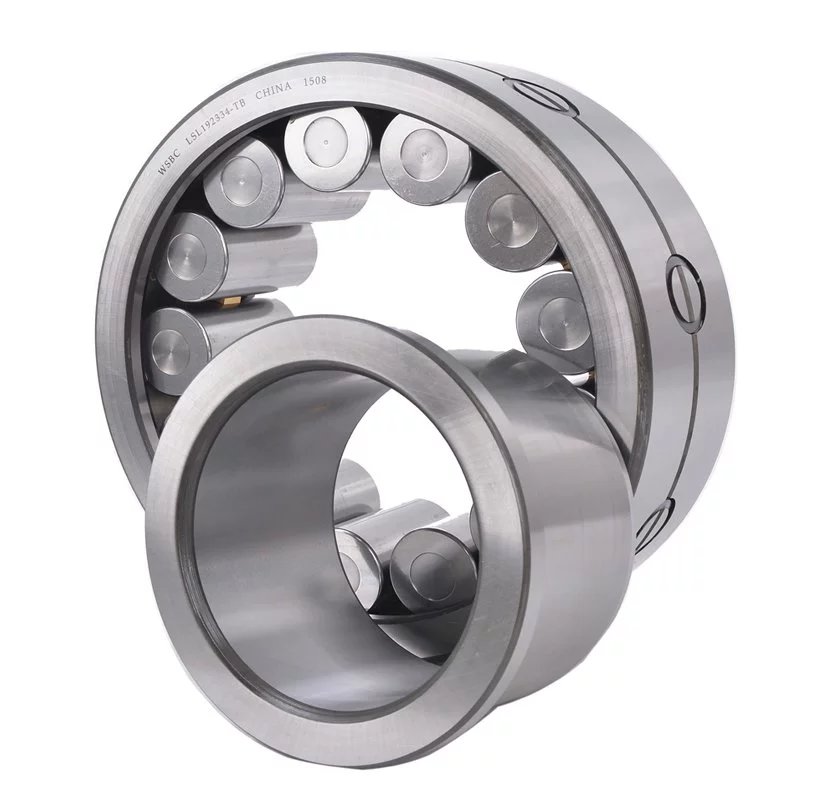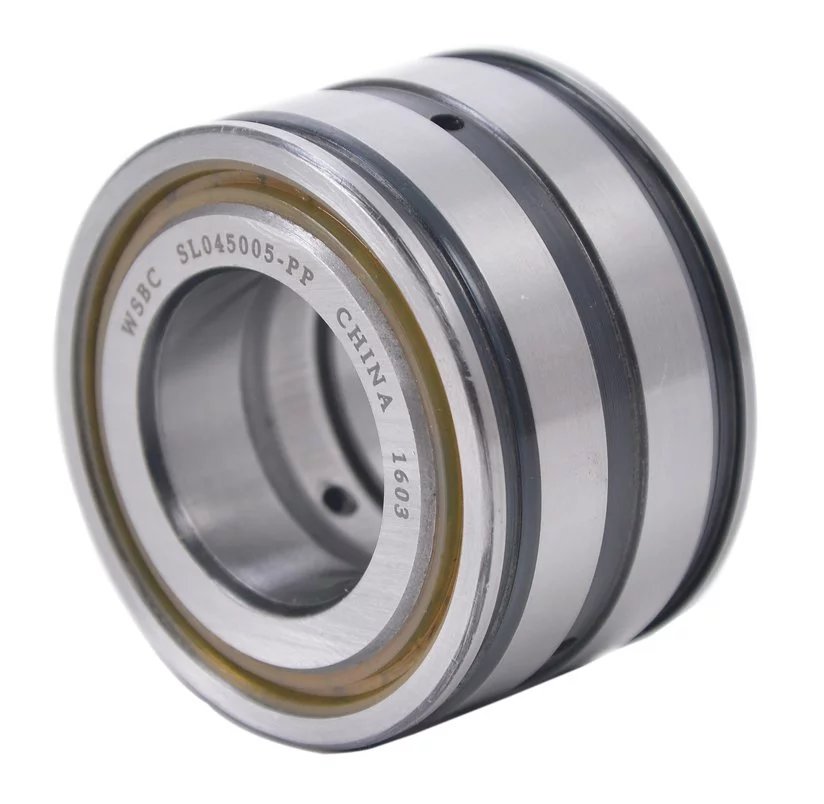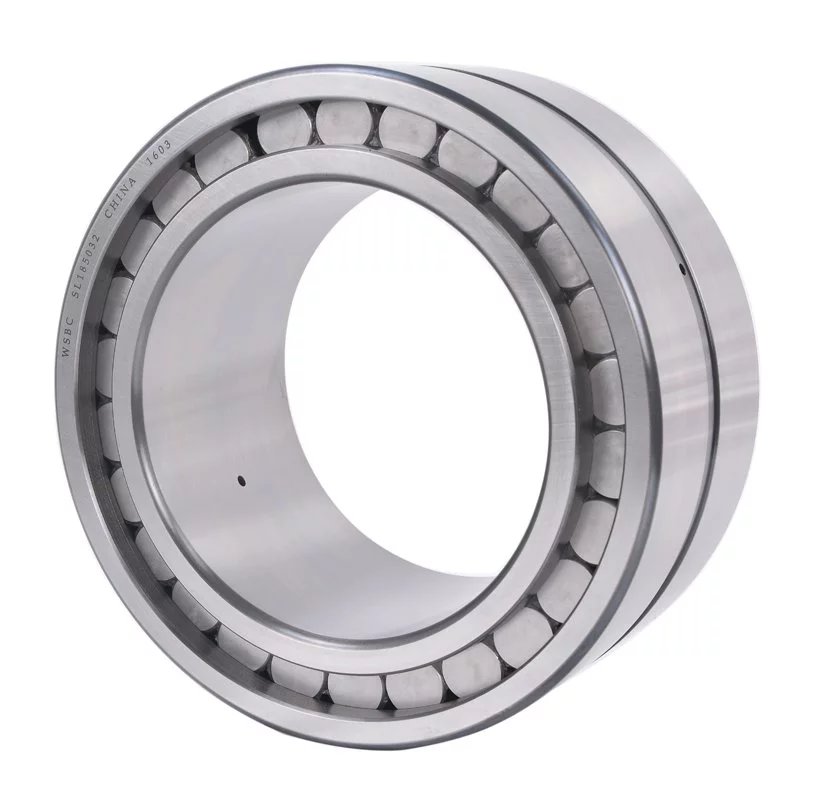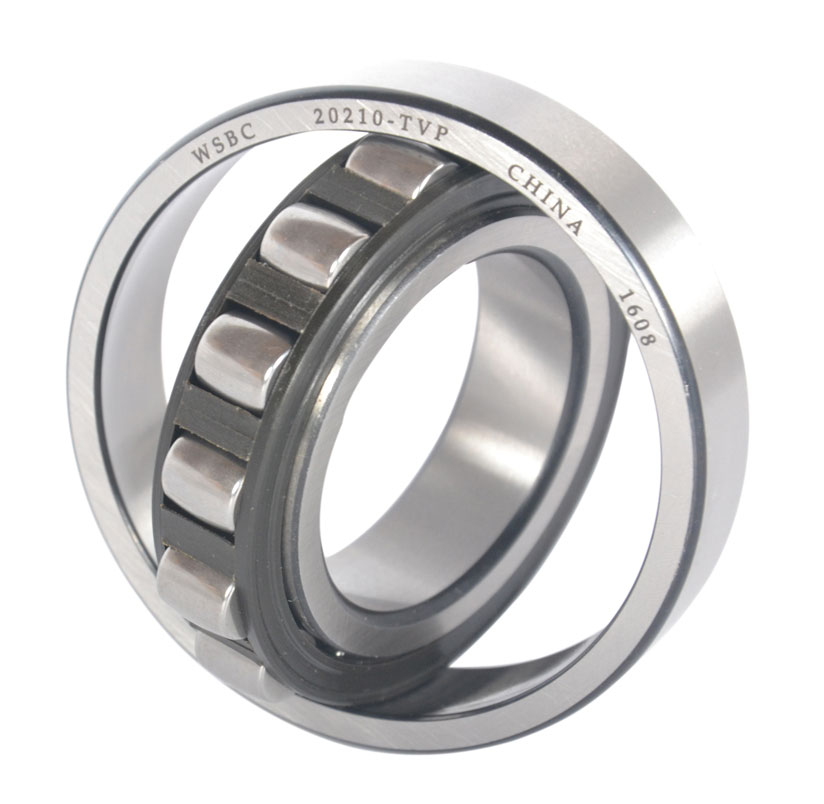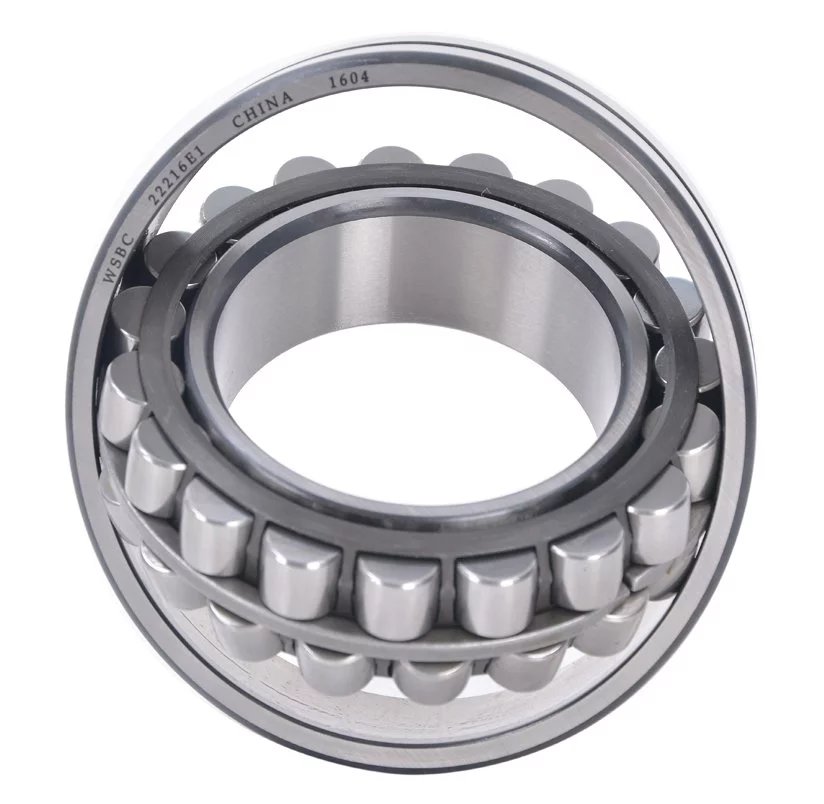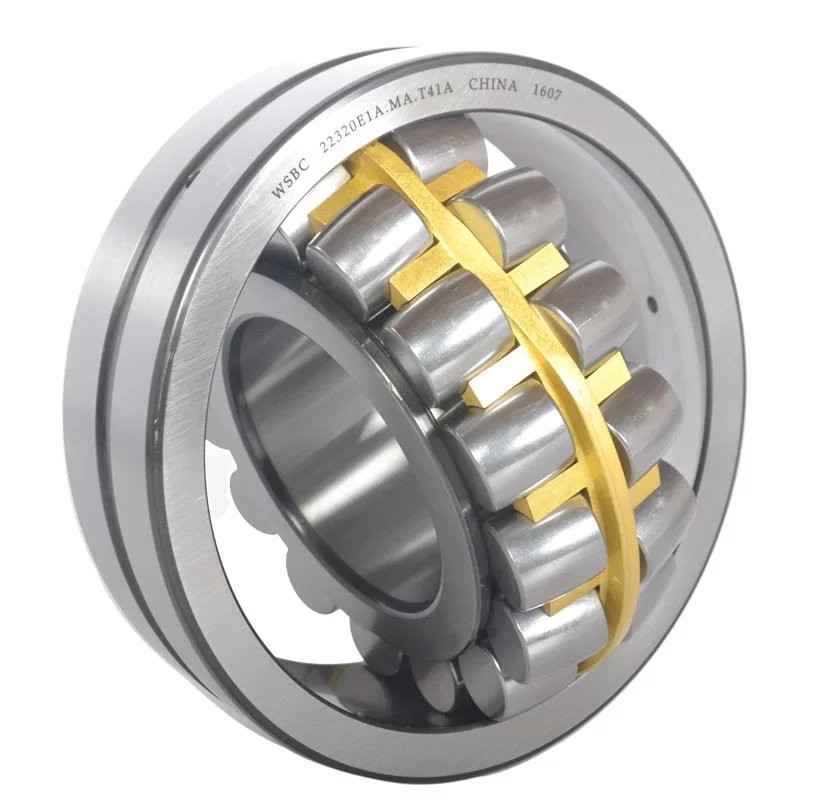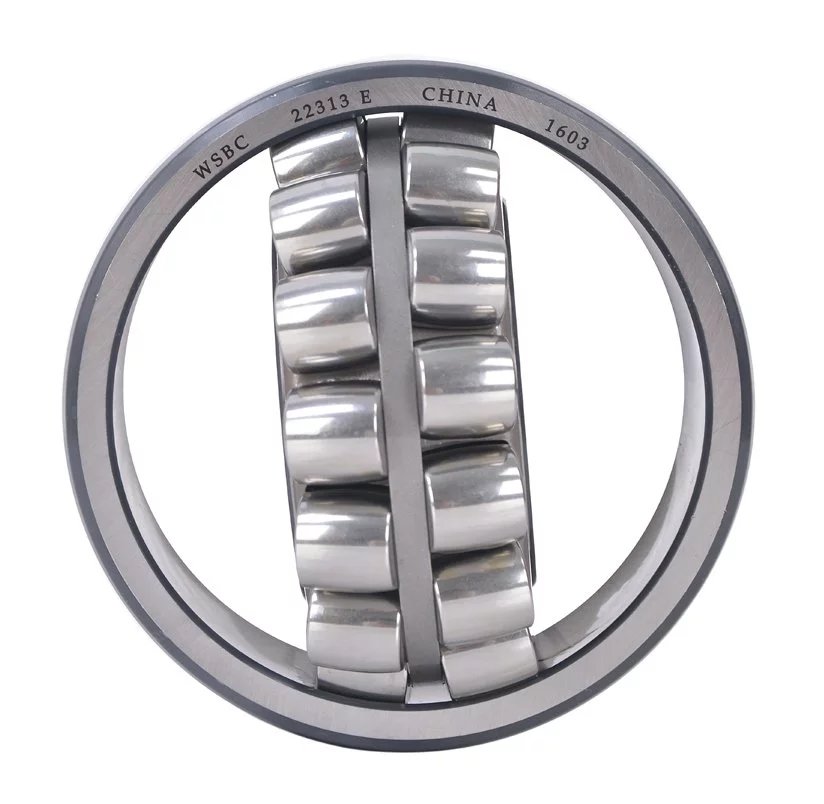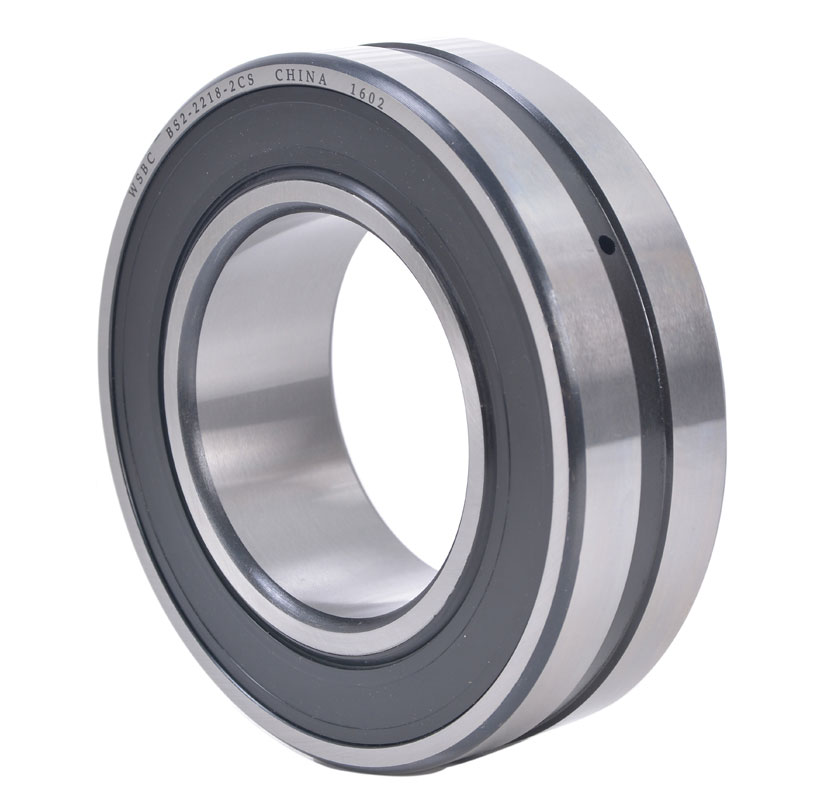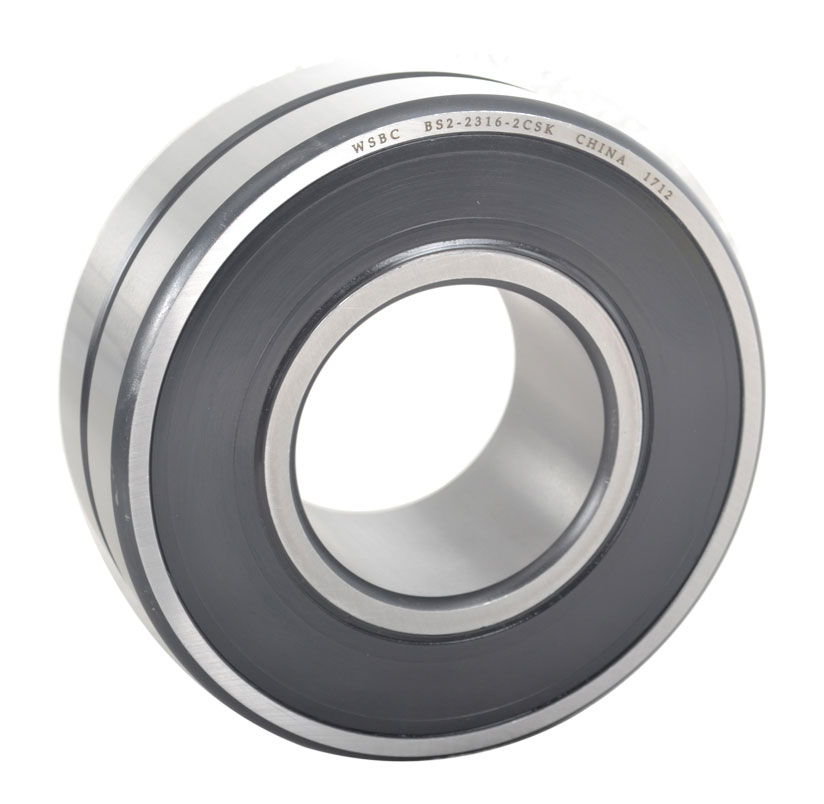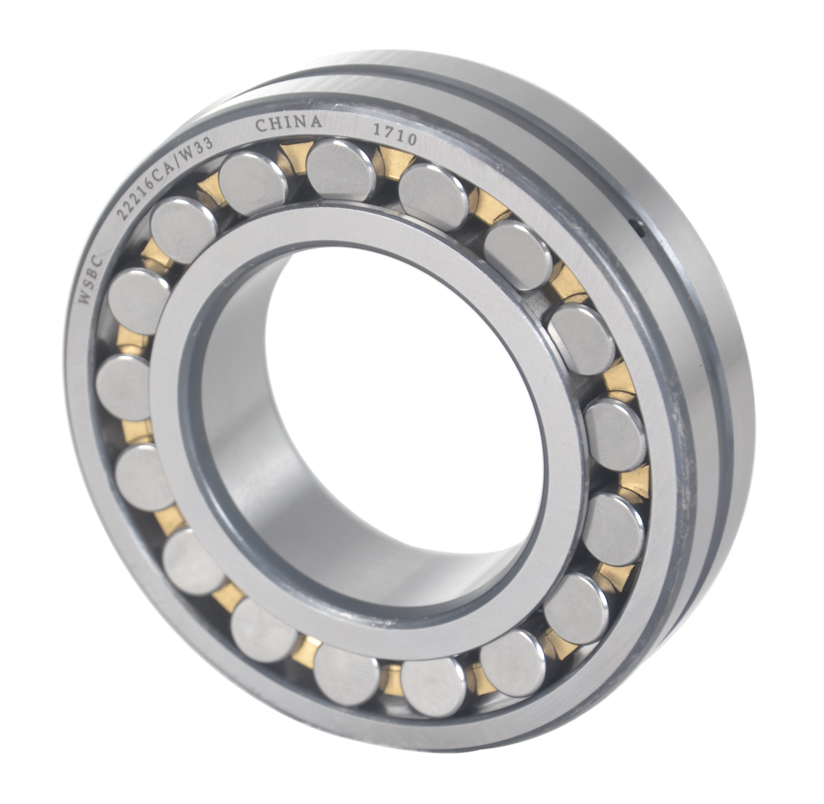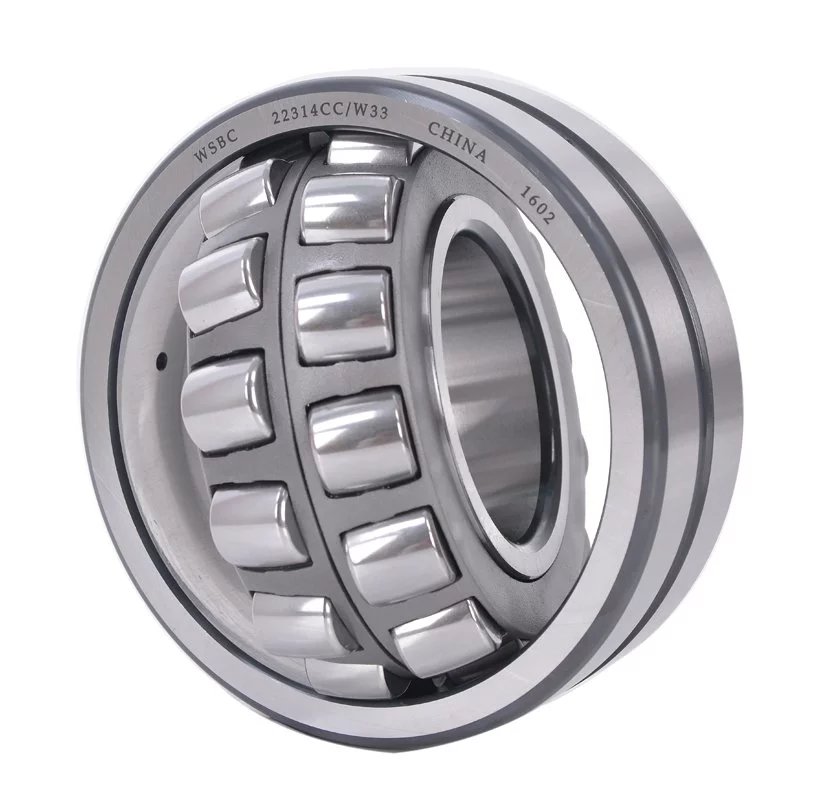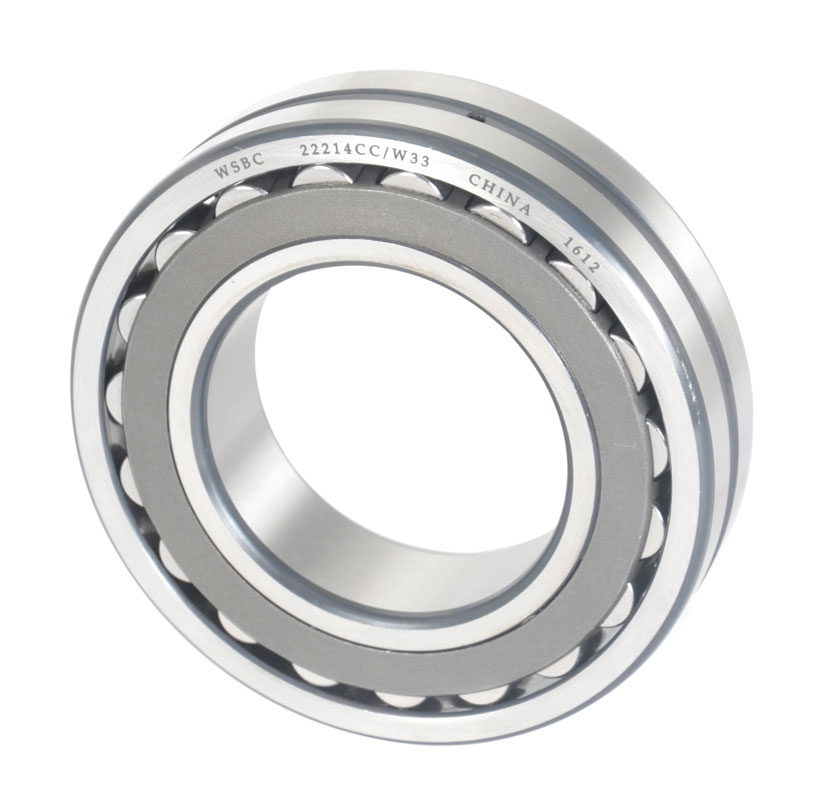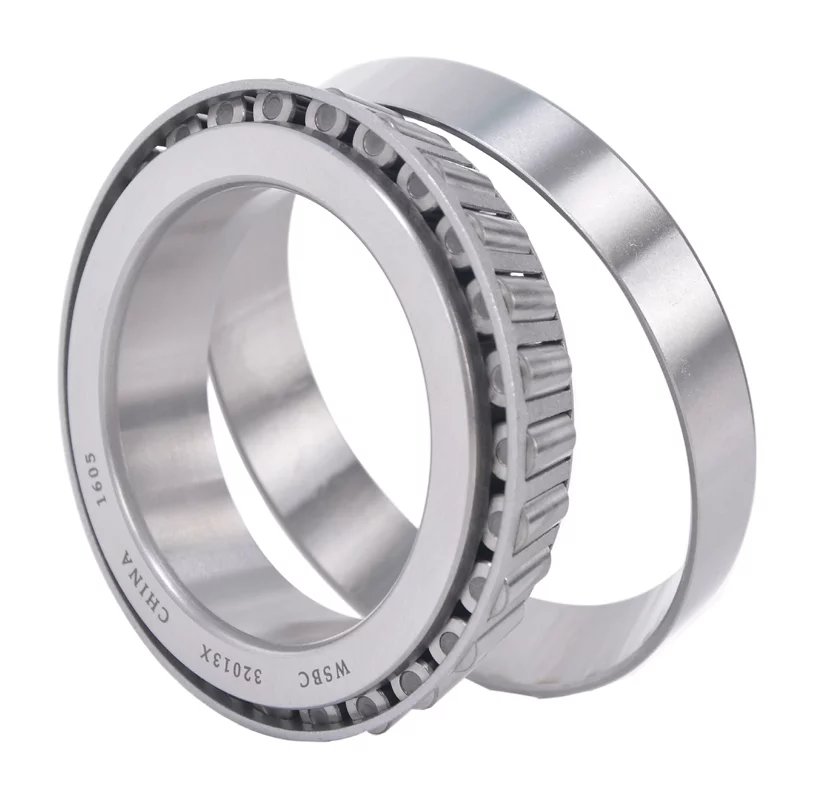News
Basic knowledge of tapered roller bearings and cylindrical roller bearings
Time:2020.03.23 Source:Roller Bearings Suppliers
Tapered roller bearings
Tapered roller bearings refer to radial thrust rolling
bearings in which the rolling elements are tapered rollers. There are two kinds
of small cone angle and large cone angle. The small cone angle mainly bears the
combined radial and axial loads mainly with radial loads. It is often used in
pairs and installed in reverse. The inner and outer races can be installed
separately. The radial and axial clearance can be adjusted during installation
and use; The large cone angle mainly bears the axial and radial combined loads,
which are mainly axial loads. Generally, it is not used to bear pure axial loads
alone. When configured in pairs (installed with the same name opposite), it can
bear pure radial loads. See the roller bearing catalog for more information.
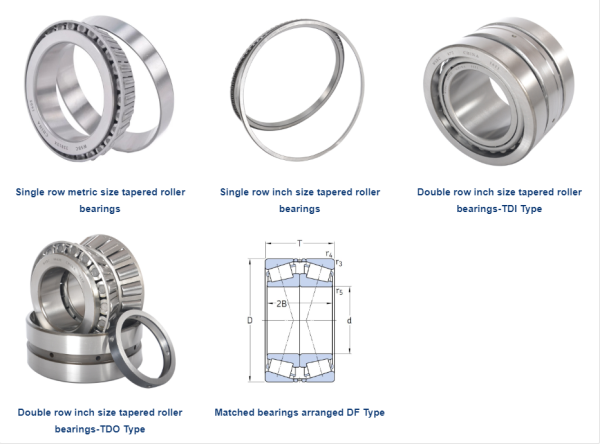
Structural characteristics of tapered roller bearings
The type code of tapered roller bearings is 30,000, and tapered roller bearings are separable bearings. In general, especially in the dimensions covered by GB / T307.1-94 "Tolerances for rolling bearings, radial bearings", the outer ring and inner components of tapered roller bearings are 100% interchangeable.
The angle of the outer ring and the diameter of the outer raceway have been standardized as the same as the outer dimensions. No changes are allowed during design and manufacture. So that the outer ring and the inner components of the tapered roller bearing can be universally interchanged worldwide.
Tapered roller bearings are mainly used to support the combined radial and axial loads, mainly radial loads. Compared with angular contact ball bearings, the bearing capacity is large and the limiting speed is low. Tapered roller bearings can withstand axial loads in one direction and can limit axial displacement of the shaft or housing in one direction. See the roller bearing catalog for more information.
Classification of tapered roller bearings (see roller bearing catalog)
The single-row tapered roller bearing has an outer ring, an inner ring and a set of tapered rollers, an inner ring assembly formed by a basket-shaped cage. The outer ring can be separated from the inner ring component. According to the ISO standard for external dimensions of tapered roller bearings, the outer ring or inner ring component of any standard tapered roller bearing should be able to achieve internationality with the same type of outer ring or inner ring component exchange. That is to say, in addition to the outer dimensions and tolerances of the same type of outer ring must comply with ISO492 (GB307) regulations, the cone angle and cone diameter of the inner ring components must also meet the relevant regulations for interchange.
Generally, the tapered angle of the outer ring raceway of a single-row tapered roller bearing is between 10 ° and 19 °, which can simultaneously bear the combined action of axial load and radial load. The larger the cone angle, the greater the ability to withstand axial loads. Bearings with a large tapered angle, with a post code plus B, with a tapered angle between 25 ° and 29 °, can withstand large axial loads. In addition, the single-row tapered roller bearing can adjust the clearance during the installation process.
The outer ring (or inner ring) of a double-row tapered roller bearing is a whole. The two small inner end faces of the inner ring (or outer ring) are close to each other, and there is a spacer in the middle. The clearance is adjusted by the thickness of the spacer. The thickness of the spacer can also be used to adjust the pre-interference of the double-row tapered roller bearing.
Four-row tapered roller bearings, the performance of this bearing is basically the same as double-row tapered roller bearings, but the radial load is greater than double-row tapered roller bearings, the limit speed is slightly lower, mainly used in heavy machinery.
Multi-sealed double and four-row tapered roller bearings, Wuxi Spark Bearing provides long-life, multi-sealed double and four-row tapered roller bearings. The bearing is individually and completely new designed, the traditional design method of the fully sealed bearing is changed, and a new type of sealing structure combining sealing and dustproof is adopted to improve the sealing effect and sealing performance. Compared with open structure bearings, multi-sealed double-row and four-row tapered roller bearings have a 20% to 40% longer life and a 80% reduction in lubricant consumption.
Uses of tapered roller bearings
Tapered roller bearings mainly bear radial and axial combined loads. Bearing bearing capacity depends on the raceway angle of the outer ring. The larger the angle, the larger the bearing capacity. This type of bearing is a separate bearing, which is divided into single, double and four-row tapered roller bearings according to the number of rows of rolling elements in the bearing. The clearance of single-row tapered roller bearings needs to be adjusted by the user during installation; the clearances of double-row and four-row tapered roller bearings have been given according to user requirements when the product leaves the factory, and do not need to be adjusted by the user.
Tapered roller bearings have tapered inner and outer ring raceways with tapered rollers arranged between them. The projection lines of all conical surfaces converge at the same point on the bearing axis. This design makes tapered roller bearings particularly suitable for bearing combined (radial and axial) loads. The axial load capacity of a bearing is mostly determined by the contact angle α; the larger the angle α, the higher the axial load capacity. The angle is represented by the calculation coefficient e; the larger the value of e, the larger the contact angle, and the greater the applicability of the bearing to the axial load. Tapered roller bearings are usually separated, that is, a tapered inner ring assembly composed of an inner ring with a roller and a cage assembly can be installed separately from the tapered outer ring (outer ring). Tapered roller bearings are widely used in automobiles, rolling mills, mining, metallurgy, plastic machinery and other industries. See the roller bearing catalog for more information.
Cylindrical roller bearings
The rolling elements of cylindrical roller bearings are cylindrical. The internal structure of cylindrical roller bearings uses rollers arranged in parallel. Spacers or spacers are installed between the rollers, which can prevent the tilting of the rollers or friction between the rollers, and effectively prevent the increase of rotational torque. See the roller bearing catalog for more information.
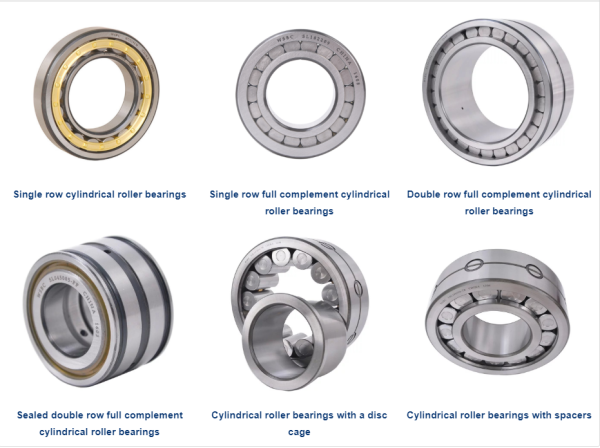
Structural characteristics of cylindrical roller bearings
1. Outer ring without rib N0000 and inner ring without rib NU0000. Cylindrical roller bearings. These bearings can accept large radial loads, high limit speeds, do not restrict axial displacement of the shaft or housing, and cannot accept axial Load.
2. NJ0000 and NF0000 cylindrical roller bearings with ribs on the inner and outer rings can restrain axial displacement of the shaft or housing in one direction, and can accept small unidirectional axial loads. NU0000 + HJ0000, NJ0000 + HJ0000 and NUP0000 bearings can restrain axial displacement of the shaft or housing in the axial clearance field of imported bearings, and can accept small bidirectional axial loads. See the roller bearing catalog for more information.
Classification of cylindrical roller bearings (see roller bearing catalog)
Cylindrical roller bearings are separate bearings and are easy to install and remove. Cylindrical roller bearings can withstand large radial loads and are suitable for use at high speeds.
This type of bearing allows the angular error (inclination) between the axis of the inner ring and the axis of the outer ring to be small, only 2 ′ to 4 ′. Therefore, the machining accuracy of the shaft and the bearing seat is relatively high. Otherwise, uneven load or stress concentration is likely to occur at the contact portion of the raceway. However, correcting the roller or raceway contact busbar can reduce the occurrence of stress concentration.
Cylindrical roller bearings can be divided into single-row, double-row, and multi-row cylindrical roller bearings according to the number of rows of mounted rolling elements. Different structural bearings are also shown in the design of the position of the ribs. The commonly used cylindrical roller bearings have the following forms:
Single-row cylindrical roller bearings: Single-row cylindrical roller bearings are separable bearings for easy installation and removal. Both ferrules can be tightly fitted. The contact line between the modified roller and the raceway can reduce stress concentration.
Double-row cylindrical roller bearings: Double-row cylindrical roller bearings are movable bearings, and their separability makes installation and removal very convenient. Both ferrules can be fitted tightly. Double-row cylindrical roller bearings are almost never allowed to have a tilt angle.
Single row bearing
N, NU type
N-type bearings have no ribs on the outer ring and ribs on both sides of the inner ring. Displacement between the shaft and the bearing housing in both axial directions can be allowed. NU type bearings have ribs on both sides of the outer ring and no ribs on the inner ring. It is also possible to allow displacement of the shaft relative to the bearing housing in both axial directions. Therefore, this type of structure is suitable for use as a moving end bearing.
NJ, NF type
NJ bearings have ribs on both sides of the outer ring and ribs on one side of the inner ring. Can withstand a certain amount of unidirectional axial load. The outer ring of the NF type has ribs on one side and the inner ring has ribs on both sides. Can also bear a certain amount of unidirectional axial load. Therefore, this type of structure is suitable for unidirectional axial positioning bearings.
NUP, NFP type
NUP type bearings have ribs on both sides of the outer ring, a (fixed) single rib on one side of the inner ring, and a separable flat retaining ring on the other side. Can withstand a certain amount of bidirectional axial load.
The NFP type bearing has a (fixed) single rib on the outer ring side, and a separable flat retaining ring on the other side, and ribs on both sides of the inner ring. Can also bear a certain amount of bidirectional axial load. This type of structural bearing can limit the displacement of the shaft relative to the bearing seat in two axial directions. Therefore, it is suitable for use as a fixed-end bearing.
NH (NJ + HJ) type
NH-type bearing is a combination of NJ-type bearing and HJ-type inclined retaining ring. Because the inner ring of the NUP type bearing is short and the flat retaining ring is not fixed, it is inconvenient to use, while the NH type bearing can use the entire inner ring width of the NJ type bearing to maintain a closer fit with the shaft. And NH type bearings are more convenient to install and disassemble.
The NH type bearing can limit the displacement of the shaft relative to the bearing seat in two axial directions. Therefore, it is suitable for use as a fixed-end bearing.
Double row bearing
Double-row cylindrical roller bearings have two kinds of structures: cylindrical inner hole and conical inner hole (bearing post code plus K). This type of bearing has the advantages of compact structure, high rigidity, large bearing capacity, and small deformation after load. It is especially suitable for machine tool spindle support. The conical inner hole can also play a role of adjusting the clearance in a small amount, and can simplify the structure of the positioning device and facilitate the installation and removal. Commonly used double-row cylindrical roller bearings have the following forms:
NN, NNU type
NN type bearings have no ribs on the outer ring, and there are ribs on both sides of the inner ring and a middle rib on the middle. It can allow two directions of displacement between the shaft and the bearing seat in the axial direction.
NNU bearings have ribs on both sides of the outer ring and middle ribs in the middle, and no ribs on the inner ring. It can allow two directions of displacement between the shaft and the bearing seat in the axial direction. Therefore, this type of structure is suitable as a movable end bearing. The cages of this type of bearings are mostly made of car-made solid cages.
NNF type
NNF type bearings are double row full complement cylindrical roller bearings. The bearing consists of an outer ring with a middle rib and two inner rings with a double rib. The rollers are guided by the ribs of the inner ring, and the two inner rings are fixed together by a fastening ring. In addition to bearing large radial and axial loads, this structure can also bear overturning moments, so it is often used as a fixed-end bearing.
NNF bearings adopt contact seals on both sides. The bearing is filled with grease. The working temperature of the grease is -50 ° C to + 110 ° C. However, due to the limitation of the sealing material, the working temperature of the bearing is limited to -40 ° C to + 80 ° C. Under good working conditions, NNF bearings with seals do not need to be maintained. If the bearings are exposed to water vapor or polluted the environment for a long time, and they are running at medium or high speed, they can be adjusted through the oil grooves and holes on the outer ring The bearings are relubricated.
Four-row bearing
Four-row cylindrical roller bearings are mainly used in cold rolling, hot rolling mills, billet rolling mills and other rolling mill machinery. The bearings have a separate structure. The bearing rings and rolling element components can be easily separated. Therefore, the bearing cleaning, inspection or Installation and disassembly are very convenient.
FC type
The FC type bearing is composed of two outer rings and one inner ring. Each side of the outer ring has a rib in the middle and a middle rib in the middle. The inner ring has no rib.
FCD type
FCD bearings are actually a combination of two NN bearings.
FC type and FCD type bearings can allow axial displacement between the shaft and the bearing housing in two directions. Therefore, this type of structure is suitable as a movable end bearing. The cage of this type of bearing mostly uses the car body 13:58.
See the roller bearing catalog for more information.
Hot Topics
Copyright © Wuxi Spark Bearings Co.,Ltd Co., Ltd All Rights Reserved. Sitemap
www.spark-bearing.com. Profession in Roller Bearings, Ball Bearings and Taper Toller Bearings-China Suppliers.
